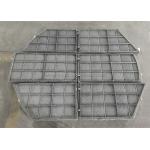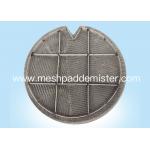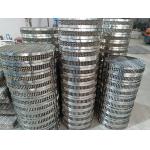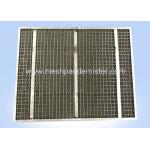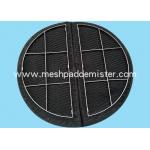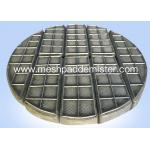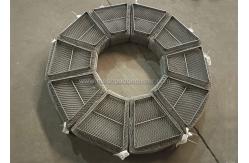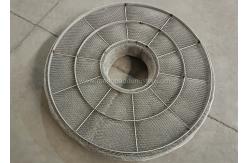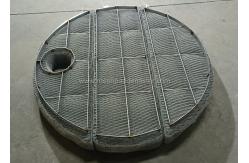Refining distillation column removal parts wire mesh demister Wire Mesh Demister Mist Eliminators Standard Specification 1. General introduction of wire mesh demister specification 1.1 ScopeA.This Standard Specification covers the general requirements for
design, construction, fabrication, and material of Mist Eliminators
specified in XXX Project Specifications.B.Exceptions or variations shown in the Project Specifications take
precedence over requirements shown herein. 1. 2ReferencesUnless noted below, use the edition and addenda of each referenced
document current on the date of this Standard Specification. When a
referenced document incorporates another document, use the edition
of that document required by the referenced document.A.American Society for Testing and Materials (ASTM) A-478,
Specification for Chromium-Nickel Stainless and Heat-Resisting
Steel Weaving and Knitting Wire.B.ASTM B-164, Specification for Nickel-Copper Alloy Rod, Bar, and
Wire. 2. Design of wire mesh demister A.Size, style, thickness, configuration, and materials are
specified in XXX Project Specification – Vessels.B.Mist Eliminator styles are defined as follows: Style | Material | Densitylb/ft3 (kg/m3) | Wire DiameterInches (mm) | A | Metallic | 9 (144.2) | 0.011 (0.28) | B | Metallic | 5 (80.1) | 0.011 (0.28) | C | Metallic | 12 (192.2) | 0.011 (0.28) | D | Polytetrafluroethylene(PTFE) | normal | 0.012 (0.30) | F | Polypropylene | normal | 0.012 (0.30) | G | Metallic | Variable5 (80.1) - 9 (144.2) | 0.011 (0.28) | V | Metallic | Other | normal |
C.Style G is a mesh blanket having a variable knitted density. The
vapor inlet section is the least dense and the outlet section the
densest. Typical inlet/outlet knitted mesh densities are 5 lb/ft3
(80.1) and 9 lb/ft3 (144.2). The customer can require variable
density blankets having slightly different knitted densities and
wire diameters.Style V is to be determined by the vendor, based on the process
conditions provided by customer. Vendor may determine the mist
eliminator type best suited to meet the mist elimination
requirement. The selected style may include a mesh pad, vane or a
combination of mesh & vanes. The mist eliminator may be
oriented vertically, horizontally or at an angle determined by the
vendor. A single pad of variable knitted density may also be
applied. 3. Materials of wire mesh demister 3.1 Metallic Mesh PadsMaterials for metallic Mist Eliminators are as per customer need.
Type 304 or Type 316 mesh pads can be in accordance with ASTM
A-478. Monel mesh pads can be in accordance with ASTM B-164.3.2 Non-metallic Mist EliminatorsNon-metallic Mist Eliminators shall be PTFE or polypropylene as
specified in by customer.3.3 SupportsA.Supports welded to the vessel shall be the same material as the
shell. Where the shell is lined, supports welded to the lining
shall be the same material as the lining.B.Supports not welded to the shell (e.g. beams) shall be the same
material as the Mist Eliminator.3.4 GridsA.Metallic grids can be the same material as the mesh padB.For non-metallic mesh pads, the grids shall be carbon steel,
coated with the same material as the mesh pad.3.5 Fastening DevicesA.For metallic mesh pads the wire ties or other fastening devices
shall be of the same material as the Mist Eliminator.For
non-metallic mesh pads, the grids shall be carbon steel, coated
with the same material as the mesh pad.B.For non-metallic mesh pads the wire ties can be the same material
as the mesh pad. 4. Applications of some main type of demister pad: MeshDensity | Eq to: YORK | Description | 80 | 931 | For a given load of mist, the highest flow velocity is achieved of
all styles. Ideal where it is required to minimize the pressure
loss, possible clogging is concerned, the size of particle to be
collected is relatively large, and/or a very high efficiency is not
required. | 144 | 431 | Used for general purposes. An efficiency of 98 to 99% is achieved
at a velocity of 1 to 5 m/sec. | 192 | 421 | Used where an especially high efficiency is required. While a
pressure loss is slightly higher, it achieves an efficiency of 99
to 100% with particle sizes 3μ or more at a velocity of 1 to 6
m/sec., and is ideal where an efficiency of 90% or more is required
at a velocity of 1 m/sec. or less. | 216 | | Used for collecting fine particles of 1 to 3μ in size.
Especially for a low-density mist of 1.0 g or less, it is used in a
thickness of 200 to 300 mm. | 432 | 333 | Used for collecting fine particles. An efficiency higher than that
of 216 can be achieved. The most remarkable characteristic is that
it provides a high efficiency with a reduced thickness. |
5. Demister Advangages: Prevention of air pollutionReduce of costly liquid loseReduce of product contaminationImprovement in process efficiencyMinimizing product losses in re-boilers & evaporatorsPreventing carbon & metal entrainment in down stream catalyst
cracker. Wire Mesh Demister shipping: |
